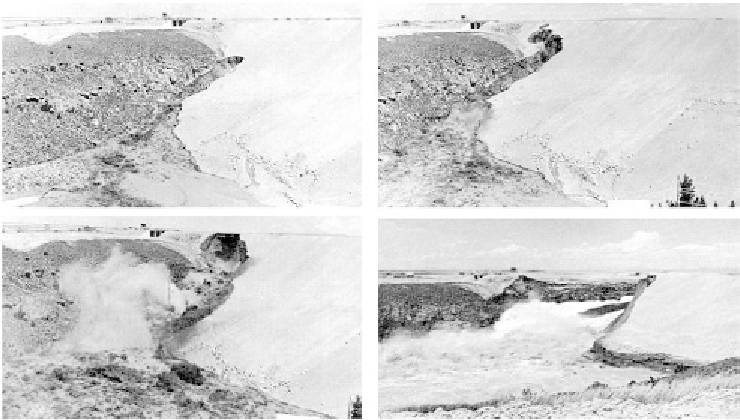Geoscience Reference
In-Depth Information
called critical gradient. For sands this value is about 1. In clay, the limited
permeability and cohesion prevent a uniform gradient to occur before swell and
consolidation have taken place. Here heave is more likely. Peat may be permeable,
but boiling is less likely due to fibres, which allow for tensile stresses. However,
peat is light and it may break under upward groundwater gradients.
Heave
Heave is uplift of semi-pervious cover layers and structures due to excessive
groundwater pressure. Similar voids may also arise under piled structures (tunnels,
pipelines, sewer lines) due to soil compaction (consolidation). Under high pore
pressures heave may cause fissures in the layer above or at the construction
interface, through which water may freely flow. It may cause erosion (colmation or
washing out of fines), when the local gradient
i
exceeds a certain value. The
common remedy is to place a weight (a filter of coarser material) on top or cast up
the zone around the leak with sand bags to create a small water pond in order to
suppress the gradient. Filters are designed using filter rules (see Chapter 16).
Figure 4.5 Piping failure of the Teton dam in 1976; pictures taken about every 30 minutes
Piping
Piping is a process of erosive channel formation in granular soil layers by
seepage. A distinction is made between reservoir-dam piping and river-dike piping.
Reservoir-dam piping concerns erosion in the cohesive dam core (clay) at constant
water-level drop. It is an important failure mechanism (Fig 4.5). River-dike piping
deals with erosion of non-cohesive soils (sand) under and at the toe of the dike at
high river-water levels (Fig 4.6). It is considered a serious failure mechanism of
flood retaining systems. Piping commonly starts at the downstream side, often with
heave and cracking of the cover layer at high water pressures. The corresponding
groundwater flow conveys sand grains, creating a cavity (pipe) underneath the

Search WWH ::

Custom Search